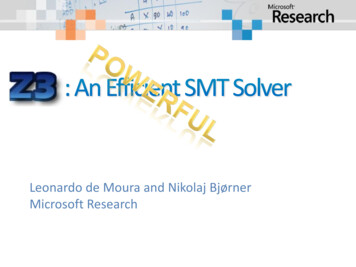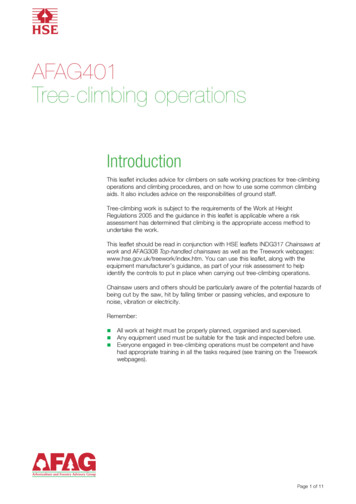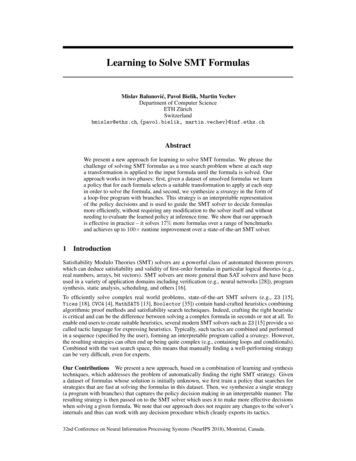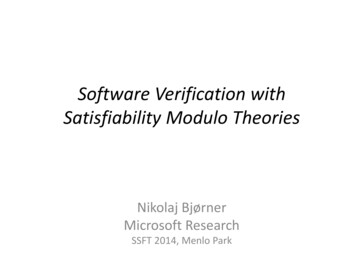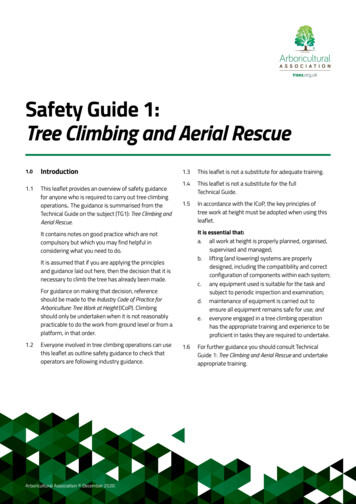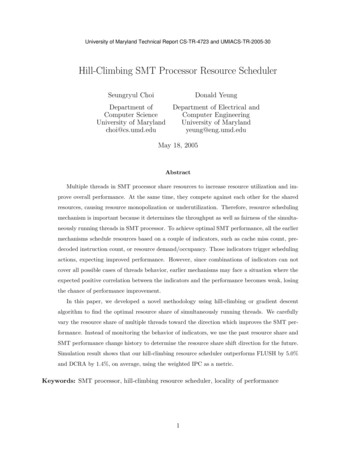
Transcription
University of Maryland Technical Report CS-TR-4723 and UMIACS-TR-2005-30Hill-Climbing SMT Processor Resource SchedulerSeungryul ChoiDonald YeungDepartment ofComputer ScienceUniversity of Marylandchoi@cs.umd.eduDepartment of Electrical andComputer EngineeringUniversity of Marylandyeung@eng.umd.eduMay 18, 2005AbstractMultiple threads in SMT processor share resources to increase resource utilization and improve overall performance. At the same time, they compete against each other for the sharedresources, causing resource monopolization or underutilization. Therefore, resource schedulingmechanism is important because it determines the throughput as well as fairness of the simultaneously running threads in SMT processor. To achieve optimal SMT performance, all the earliermechanisms schedule resources based on a couple of indicators, such as cache miss count, predecoded instruction count, or resource demand/occupancy. Those indicators trigger schedulingactions, expecting improved performance. However, since combinations of indicators can notcover all possible cases of threads behavior, earlier mechanisms may face a situation where theexpected positive correlation between the indicators and the performance becomes weak, losingthe chance of performance improvement.In this paper, we developed a novel methodology using hill-climbing or gradient descentalgorithm to find the optimal resource share of simultaneously running threads. We carefullyvary the resource share of multiple threads toward the direction which improves the SMT performance. Instead of monitoring the behavior of indicators, we use the past resource share andSMT performance change history to determine the resource share shift direction for the future.Simulation result shows that our hill-climbing resource scheduler outperforms FLUSH by 5.0%and DCRA by 1.4%, on average, using the weighted IPC as a metric.Keywords: SMT processor, hill-climbing resource scheduler, locality of performance1
1IntroductionThe multiple threads in SMT processor share resources to improve overall performance [1, 2]. But,at the same time, they compete against each other for shared resources. Without proper resourcescheduling, resource may be held by a thread, which does not fully utilize it, losing the throughput.In addition, some threads may monopolize resources and other threads may be discriminated,losing the fairness. Another important reason for SMT resource scheduling is that each threadhas different resource requirement, and the amount of performance degradation, when the givenresource is less than the thread’s demand, varies significantly. Therefore, the resource schedulershould give more resources to a thread that degrades the performance the most without them.In SMT processor, complex competitions and interactions happen among multiple threads forthe shared resources, requiring carefully designed resource scheduler.1.1Hill-climbing resource schedulerThe basic idea of hill-climbing or gradient descent algorithm is to always head toward the bestneighboring state, which is better than the current one. By moving this way, we eventually reachthe peak of the hill (or the best state). If the hill-defining function is derivative, the gradient vectorguides the best movement direction.We applied the hill-climbing algorithm to SMT processor resource scheduling and developed anovel hill-climbing resource scheduler. Our goal here is to achieve the best performance of SMTprocessor by finding the optimal hardware resource share among multiple threads. Figure 1 showsan example of SMT processor performance for all combinations of RUU resource share among threethreads. The arrow mark indicates the optimal resource share, which all resource schedulers arelooking for. As Figure 1 shows, the shape of the performance graph looks like hill. This motivatesus applying hill-climbing algorithm to finding the optimal resource share of multiple threads.Please note that each data point in Figure 1 requires an SMT simulation and it is not possibleto figure out the whole shape of the hill at run time. In hill climbing resource scheduler, however,we just need to know the shape of the neighboring positions to make decision on future movement.More specifically, our hill-climbing resource scheduler carefully varies the resource share of multiplethreads toward the direction which improves the SMT performance. We use the past resource shareand SMT performance change history to determine the resource share shift direction for the future.2
(a)(b)(176,16,64) RUU mesa(c) (80,112,64) RUU mesa RUU vortex(d)(48,144,64)')" #'"!'""'"%'" '(#'(!'("'(%''( ''%%#!''%%"%'% RUU vortex RUU mesa RUU vortex(144,16,96) % #&!""RUU mesa%# "#! % #&!""# %"#!RUU vortexFigure 1: The performance of SMT processor when mesa, vortex, and fma3d run simultaneously.(a) and (c) show the sum of IPC at 1600K and 1760K processor cycle, respectively. (b) and (d)show the sum of weighted IPC at 1600K and 1760K processor cycle, respectively. In each graph,the arrow indicates the peak of the hill. Since the total number of RUU is fixed, the number ofRUU allowed to the last application, fma3d, is dependent on those of the other two applications.So, the number of RUU for fma3d is not shown in the graph.3
1.2Related WorkEarlier SMT resource schedulers control fetch speed or key resource allocation at run time tomaintain proper resource share among multiple threads. Their resource scheduling actions aretriggered or guided by indicators, such as cache miss count, pre-decoded instruction count, andresource demand/occupancy.ICOUNT [2] and FPG [3] favor fast threads, which cause fewer cache misses or fewer branchmis-prediction, by giving fetch priority to threads that consume smaller amount of pre-decodestage resources or shows high branch prediction accuracy. Therefore, ICOUNT and FPG improvethroughput by increasing the IPC of the fast threads. However, pipeline may be clogged by athread with long latency operations, thus reducing the throughput.STALL [4] minimizes the pipeline clog by stalling fetch of a thread when long latency operationis detected. However, at the time this mechanism detects a long latency operation, it may be toolate and a thread may hold many resources until the long latency operation is serviced.FLUSH [4] corrects the late detection of the pipeline clog by flushing instructions of a threadwith long latency operation. This forces the victim thread to release the resources immediately.However, flushing requires more fetch bandwidth and power consumption.STALL-FLUSH [4] minimizes the number flushed instructions by, first, stalling a thread whenlong latency operations are detected, and second, flushing the thread when resource is exhausted.However, both FLUSH and STALL-FLUSH prevent exploiting memory parallelism because theytend to allow only one outstanding L2 cache miss at a time per thread.DCRA [5] favors memory-bound threads by giving pre-computed large share of resources tothreads with outstanding L1 cache miss. Therefore, memory-bound threads enjoy memory parallelism. In addition, compute-bound threads are allowed to use resources from memory-boundthreads when they are not used, thus increasing the resource utilization. However, the resourceshare computing formula may give more resources than is necessary to memory-bound threads,which does not have any memory parallelism, causing inefficiency. In other words, classifyingthreads into two groups (with or without L1 cache miss) may not represent the variety of thethread characteristics.The difference between earlier SMT resource schedulers and hill-climbing resource scheduler canbe viewed in five aspects. All the earlier mechanisms rely on indicators to schedule resources. On the contrary, our4
mechanism uses the past performance. Figure 2 visualizes this difference. Our experimentshows that hill-climbing resource scheduler outperforms earlier mechanisms because of thefollowing two reasons. First, as we discussed earlier in this section, the combinations ofindicators can not cover all possible cases of threads behavior. Therefore, earlier mechanismsmay face a situation where the expected positive correlation between the indicators and theperformance becomes weak, losing the chance of performance improvement. Second, theperformance of the future is likely to be similar to that of the past, which we call locality ofperformance and detail in Section 2.3. The static resource sharing models [6, 7, 8] have fixed resource partitions to ensure fairresource share among multiple threads at the cost of decreased resource utilization. However,resource schedulers [2, 3, 4, 5] dynamically control the resource share at run time based onthe indicators. Hill-climbing resource scheduler lies between static resource sharing modeland earlier resource schedulers in terms of resource share update frequency. In hill-climbingresource scheduler, the resource share is updated every pre-determined amount of processorcycle, which we call epoch and detail in Section 2.2. The goal of all the SMT resource schedulers is to reach the peak of the hill, which is definedas an SMT performance, by finding the optimal resource share. We are the first focusing theshape of the hill and searching for the peak. Our approach is a natural way of handling theresource scheduling problem. Depending on our performance goal, the performance-defining (or hill-defining) function canbe either one of the average IPC, average weighted IPC [2], or harmonic mean of weightedIPC [9]. In either case, our hill-climbing algorithm searches optimal resource share thatmaximizes the function value. Since hill-climbing algorithm is a generic methodology for solving optimization problems, wecan extend our hill-climbing resource scheduler to solve similar problems, like cache partitioning or bandwidth partitioning.The rest of the paper is organized as follows. Section 2 describes our hill-climbing resourcescheduler. Section 3 explains the experimental methodology. Section 4 presents the performanceof the hill-climbing resource scheduler. Finally, in Section 5, we conclude our research.5
(b)IndicatorsCache miss countResource Occupancy(a)Resource SharePerformanceChangesResource DemandFigure 2: The way of maintaining proper resource share among multiple threads by (a) earlierresource schedulers and (b) hill-climbing resource scheduler.2Hill-climbing resource schedulerWe identified RUU as the most important shared resource because the contention against RUUtends to exist longer than any other resource contentions. For example, when a thread has a datacache miss, the cache miss load and all the subsequent instructions belonging to the same threadcan not release RUU entries until the cache miss is serviced. Compared to RUU, pipeline bandwidthand functional unit does not cause hold-and-wait situation, decreasing the needs for scheduling.Therefore, in this research, we focus on scheduling RUU entries. Shared fetch queue is implicitlytaken care of by our scheduler because we prioritize or stall fetching threads to control RUUoccupancy. It is important to note that our hill-climbing resource scheduler is generic methodologyand can be applied to any shared resources, if they need scheduling.2.1Issues on hill-climbing resource schedulerThere are several issues on hill-climbing resource scheduler, which are generic to all hill-climbingalgorithm implementations or specific to our mechanism. The listed issues below are addressedin the Section 2.2 and Section 2.3 when we describe the implementation of hill-climbing resourcescheduler.Hill shape change: The shape of the hill keeps changing as the characteristics of threads changeat run time. Figure 1 visualizes the hill shape changes. The hills in (a) and (b) are changed to (c)and (d), respectively, after 160K cycles. As these figures show, the shape and the position of thepeak of the hill is shifting over time. Therefore, we should keep searching for the moving target.Gradient computation: Ideally, we need to move toward the gradient vector. However, theperformance function, which represents our hill, is not well formed formula nor derivative. Theonly way of figuring out shape of the hill is to pick sample positions and evaluate their performanceone by one. Out of those sample performance, we can compute movement direction.Local maxima: Generally, local maxima is a big issue in hill-climbing algorithm and we need a6
mechanism to escape from the local maxima. However, it is not a concern in our case, because the“hill shape change” effectively acts as a perturbation (or shaking the hill) to help escaping from thelocal maxima. In addition, the performance of each individual thread is monotone non-decreasingas the amount of allowed resource to the thread is increasing. Therefore, the SMT performance,as a function of resource partition size of all running threads, generally has small number of localmaxima, if any.Searching speed: Generally, the searching speed is important for hill-climbing algorithm becauseof the large search space, many local maxima, and significant amount of iterations to reach withinthe acceptable error range. In our case, the search space is small, there are fewer amount of localmaxima, and it takes few iterations to reach the goal. However, there are three reasons why weneed fast searching speed. First, as the shape of the hill is changing, the speed of searching the peakof the hill should be faster than that of the hill shape change. Second, sampling based gradientcomputation makes things worse because sampling the performance takes several thousands ofprocessor cycles, delaying the time to find a direction for the next movement. Third, during thetime we are on the way to the peak of the hill, threads are using less optimal resource share, thuslosing the performance of the SMT processor.2.2Hill-climbing resource schedulerWe use hill-climbing algorithm to implement our hill-climbing resource scheduler. There are severalterms that we defined to describe the hill-climbing resource scheduler.Epoch: Execution time is divided into equal sized epochs, which we set to be 32K processorcycle. Between epochs, we choose the next sample position, and during each epoch, we evaluatethe performance of the sample position.Performance evaluation function: The performance evaluation function defines the hill thatour resource scheduler climbs. Depending on the performance goal, the performance evaluationfunction can be either one of (1) average IPC, (2) average weighted IPC, (3) harmonic mean ofweighted IPC, or (4) IPC of a high priority thread. Once a function is chosen, our algorithm willsearch for the optimal resource schedule that maximizes the function value.Advantaged thread: Between epochs, one thread is elected to be the advantaged thread. Eachthread takes turns in round robin fashion and becomes the advantaged thread. The sample positionfor the subsequent epoch is chosen toward giving more resources to advantaged thread.Delta: The amount of additional resources given to the advantaged thread is determined by deltai7
of the advantaged thread i. If the sample movement toward giving more resources to threadiimproves the SMT performance, we increment deltai by 2. Otherwise, we set deltai to 1.Resource partition: Between epochs, the sample position is computed by incrementing theresource partition for the advantaged thread by (deltaadv (N 1)), and decrementing the resourcepartitions for the non-advantaged threads by deltaadv , where thread adv represents the advantagedthread and N represents the total number of running threads. After an epoch, we check if theadvantaged thread fully exploits its given chance by evaluating the performance during the previousepoch. If the SMT performance of the previous epoch becomes better than that of the past epochs,we accept the sample position and consider it as the current position. Otherwise, we discard thesample position.Performance of the past epochs: We have to decide whether the performance of the previousepoch is improved over that of the past epochs. For this purpose, we maintain the performance ofthe past epochs, which ispast perf cur perf p past perf (1 p)(1)As the formula implies, the variable past perf is updated partly (p) by the most recent performanceand partly (1 p) by the old performance.Figure 3 describes hill-climbing resource scheduler in pseudo code. The hardware unit forresource scheduler is invoked every Epoch Size cycles to execute the routine (line 6). There aretwo shaded boxes in Figure 3. Box (a) evaluates the performance of the previous epoch. Box(b) sets up the new partition for the next epoch. In box (a), if the performance of the previousepoch is improved (line 8), we accept the partition used for the previous epoch and incrementthe delta[adv thread] (line 10). Otherwise, we roll-back the partition (line 12-15) and decrementthe delta[adv thread] (line 16). In box (b), we elect a new advantaged thread (line 20) and giveadvantage by increasing the resource partition for the advantaged thread (line 21-24).Figure 4 shows an example hill-climbing resource scheduling of the RUU resource among threethreads running on SMT processor. In this figure, (p0 , p1 , p2 ) represents the coordinate in thesearch space, where pi is the amount of RUU entries allowed to threadi . Because of the constraint,p0 p1 p2 256 ( total RU U size), the search space is two dimensional. The vector di indicatesthe movement direction when threadi is advantaged thread. In this example, d0 (2, 1, 1),d1 ( 1, 2, 1), and d2 ( 1, 1, 2). Initially our search begins at the center of the space, whichis (85, 85, 86). A sequence of vectors, labeled as a, b, c, d, e, f, and g, shows an example of8
1.2.3.4.5.#define Epoch Size#define N#define Upper Bound#define eval perf(X)#define decay(X, Y)32kTotal number of running threadsThe upper bound of delta. We used 9Evaluate the over all performance of SMT during the epoch X.Decay and compute the past performance. We used (X * 0.25 Y * 0.75)6.7.For every Epoch Size cycles {perf eval perf(epoch id);// evaluate the performance of the previous epoch8.9.10.11.12.13.14.15.16.17.if (perf past perf) {if (delta[adv thread] Upper Bound)delta[adv thread] 2;} else {partition[adv thread] - delta[adv thread] * (N - 1);for (i 0 ; i N ; i )if (i ! adv thread)partition[i] delta[adv thread];delta[adv thread] 1;}// previous epoch performs better than the past epochs// accept the partition and increase delta18.past perf decay(perf, past perf);// set the past performance19.20.epoch id ;adv thread epoch id % N;// update epoch id// elect a new advantaged thread21.22.23.24.25.partition[adv thread] delta[adv thread] * (N - 1);for (i 0 ; i N ; i )if (i ! adv thread)partition[i] - delta[adv thread];// try new partition for the new advantaged thread// rollback to the previous partition// decrease delta }Figure 3: Hill-climbing resource scheduler implementation in pseudo code. The shaded box (a)evaluates the performance of the previous epoch and (b) sets up the new partition for the nextepoch.resource scheduling movement trail.2.3Design choicesThere are several design choices that we made for the hill-climbing resource scheduler implementation.Movement direction: The general hill-climbing algorithm needs gradient. However, we can notcompute gradient because the shape of the hill is represented not as a well formed function, but asperformance outcome. So, we try a sample position around the current one for an epoch and measure the performance. Based on this trial, we can take the sample movement as a starting positionof the next trial or discard the sample movement. There are two alternative implementations inchoosing the movement direction: breadth first search (the direction to try is chosen in round robinfashion) and depth first search (pursue one direction until there is no performance improvement).Based on our experiment, breadth first search performs better than depth first search, because thelatter exhibits longer searching path. So, the algorithm presented in Figure 3 uses breadth first9
(256, 0, 0)(128, 0, 128)(0, 0, 256)gfeda(p0, p1, p2), pi is the RUUpartition size for thread icd0di is the delta vector for thread i,when thread i is advantaged thread,the movement is taken to di direction(85, 85, 86)bd2(128, 128, 0)(0, 128, 128)d1(85, 85, 86) is the initial positionpresents example movements, wherea: before epoch 0, advantaged thread is 0b: after epoch 0, advantaged thread is 1c: after epoch 1, rolled back thread is 1d: after epoch 1, advantaged thread is 2e: after epoch 2, advantaged thread is 0f: after epoch 3, advantaged thread is 1g: after epoch 4, advantaged thread is 2(0, 256, 0)Figure 4: The search space for hill-climbing resource scheduler and example movement. We scheduleRUU resource for three threads.search by making advantaged thread in round robin fashion.Adaptive delta: As the delta becomes larger, the searching speed becomes faster, but thereis more chance of passing over the optimal position. In addition, once we reached an optimalposition, large delta will degrade the performance because it tries a position which is far away fromthe optimal one for an epoch and then returns to the optimal position again and again. Therefore,we chose to have per thread adaptive delta. If the movement toward favoring a threadi increasesthe performance, we increment the deltai to accelerate the movement. Otherwise, we set the deltaito 1.Decaying the performance of the past epochs: To decide whether the performance of theprevious epoch is improved or not, we need to maintain the performance of the past epochs asa reference. One way of maintaining the past performance is keeping the maximum performancethat we found so far, which allows only the movement that outperforms any of the previous one.However, the shape of the hill keeps changing and the maximum performance of present (or future)10
may be less than the maximum performance that we found so far. Therefore, we need to decay theperformance of the past epochs. Our choice is using the most recent performance as well as the oldperformance as shown in Equation 1. This equation implies a moving average of the performancealong the past trail, giving the largest weight to the most recent position. The empirically chosenvalue of the weight for the most recent position (p in Equation 1) is 0.25.Maintaining the locality of performance: As we mentioned, the shape of the hill keeps changing and we are searching for the moving target. In this environment, we use the performance of theearlier history to schedule resources for the future. To make our resource scheduler working, weneed to assume the locality of performance behavior, which we defined as if the performance of aposition P is an optimal one, the optimal position in near future will be close to P. In other words,locality of performance assumes that the shape of the hill changes slowly. With this assumption,the optimal resource share, which our resource scheduler found so far, can be the best startingpoint of the searching for the future resource share. Two factors affect the locality behavior, theepoch size and the application characteristics. Epoch size: As the size of the epoch becomes smaller, the shape of the hill changes fasterbecause the shape is volatile and affected by any small events, losing the locality of performance behavior. As the size of the epoch becomes larger, the hill shape changes slowly, butit does not represent the real shape of the hill due to the summary error. Therefore, we wantto make the epoch size as small as possible. But, it is bound to the locality of performancebehavior. We tried several epoch size and 32K-cycle has the best performance. Application characteristics: Our observation shows that the hill shape change frequency depends on the application characteristics. When the application characteristics change slowly,our hill-climbing resource scheduler works fine. When the application characteristics changefast, however, our method can not catch up with the hill shape changes. As a result, our searchignores high frequency hill shape changes and follows more coarse grained shape changes, thuslosing the chance of finer grained, or more accurate, resource scheduling. We will experimentthe effect of the application characteristics change on our scheduling in Section 4.4.2.4Hill-climbing resource scheduler implementationFigure 5 shows the block diagram of hardware modifications to implement hill-climbing resourcescheduler. As the figure shows, hill-climbing resource scheduler uses the number of committed11
(Optional)Thread erCommitInstructionResourcePartitionFetch ControlFetchHoldResourceDispatchIssueResource UsageCounterExecuteReleaseResourceWrite BackCommitFigure 5: The block diagram of hill-climbing resource scheduler implementation in hardware.instructions to compute the performance of the previous epoch. Depending on the definition of theperformance, the resource scheduler optionally needs externally given thread priority to computeperformance. Fetch unit compares the resource partition computed by the resource scheduler andresource usage counter to prioritize (or stall) thread fetching.We need three counters per thread: committed instruction counter, which is embedded in mostof the modern processor, resource usage counter, which is updated every time resource is held andreleased by a thread, and resource partition register, which is updated every epoch by the resourcescheduler and referenced every cycle by the fetch unit.In the implementation of Figure 3, the most expensive control logic is the performance evaluationpart (line 7 - 8), which needs to compute either one of sum of IPC, sum of weighted IPC, or harmonicmean of weighted IPC1 . However, since our hill-climbing resource scheduler is invoked infrequently(i.e. every epoch), the latency of the control logic is not critical, thus simplifying the logic design.Alternatively, the algorithm in Figure 3 can be implemented in software and invoked everyepoch by the timer interrupt. It is a feasible approach because the execution time of the routinein Figure 3 is very small compared to the epoch size. In software implementation, the requiredadditional hardware budget becomes minimized at the cost of run-time context switch overheadand scheduling delay. In this paper, we assume hardware implementation of hill-climbing resourcescheduler.1We’d better minimize the inverse of the harmonic mean, instead of maximizing the harmonic mean12
Processor ParametersFetch/Issue/Commit width8/8/8RUU / LSQ / IFQ size256 / 128 / 32Functional unit8-Int Add, 4-Int Mul/Div, 8-Memory port, 8-FP Add, 4-FP-Mul/DivBranch Predictor ParametersBranch PredictorHybrid gshare/Bimodalgshare / Bimodal Predictor Size8192 / 2048Meta Table Size8192BTB Size2048, 4 wayRAS Size64Memory ParametersIL1 config64kbyte, 64byte block size, 2 way, 1 cycle latencyDL1 config64kbyte, 64byte block size, 2 way, 1 cycle latencyUL2 config1Mkbyte, 64byte block size, 4 way, 20 cycle latencyMem config200 cycle first chunk, 6 cycle inter chunkTable 1: SMT simulator settings.3MethodologyTo evaluate the performance of hill-climbing resource scheduler, we developed detailed event drivenSMT simulator based on SimSSMT used in [10], which is derived from SimpleScalar [11]. Table 1lists our SMT processor settings.The hill-climbing resource scheduler computes the amount of RUU entries allowed to eachthread. When a thread consumes all of its given amount of RUU, we stall fetching the thread. Inaddition, we give fetch priority to a thread with largest difference between the allowed amount andthe current consumption of RUU resource.To choose the representative simulation window, we ran SimPoint [12] up to 16G instructions.And then, we picked the earliest representative region out of 16G-instruction range. Table 2 showsthe number of instructions that we skipped before the performance simulation.Table 2 lists 22 SPEC{int, fp}2000 applications used in our study. We used pre-compiledalpha binary from Chris Weaver2 , which is compiled with highest optimization level. We simulatedapplications using reference input set. Table 3 shows the simulation workload. We referenced twoearlier researches, [4] and [5], to choose and group applications. As the table shows, we classified2His SPEC2000 alpha binary is available at SimpleScalar web page.13
sswimSkip kip ILPILPILPILPILPILPMEMMEMMEMMEMMEMTable 2: SPEC2000 applications included in the experiment.the workload into 6 groups based on the L2 cache miss frequency (ILP, MIX, and MEM) and thenumber of simultaneously running threads (2 and 4). After skipping instructions from all thread,we simulated 500M instructions.44.1Evaluating hill-climbing resource schedulerDefinition of performanceWe evaluate the performance of SMT resource schedulers in terms of three metrics: average IPC,average weighted IPC [2], and harmonic mean of weighted IPC [9]. They are defined in Equation 24, where IP Ci is the IPC of threadi in SMT environment, SingleIP Ci is the IPC of stand-aloneexecution of threadi , and N is the number of simultaneously running threads.Average IPC PAverage Weighted IPC IP CiNP(2)IP CiSingleIP CiNNHarmonic Mean P SingleIP Ci(3)(4)IP
resource scheduler, the resource share is updated every pre-determined amount of processor cycle, which we call epoch and detail in Section 2.2. The goal of all the SMT resource schedulers is to reach the peak of the hill, which is defined as an SMT performance, by finding the optimal resource share. We are the first focusing the
